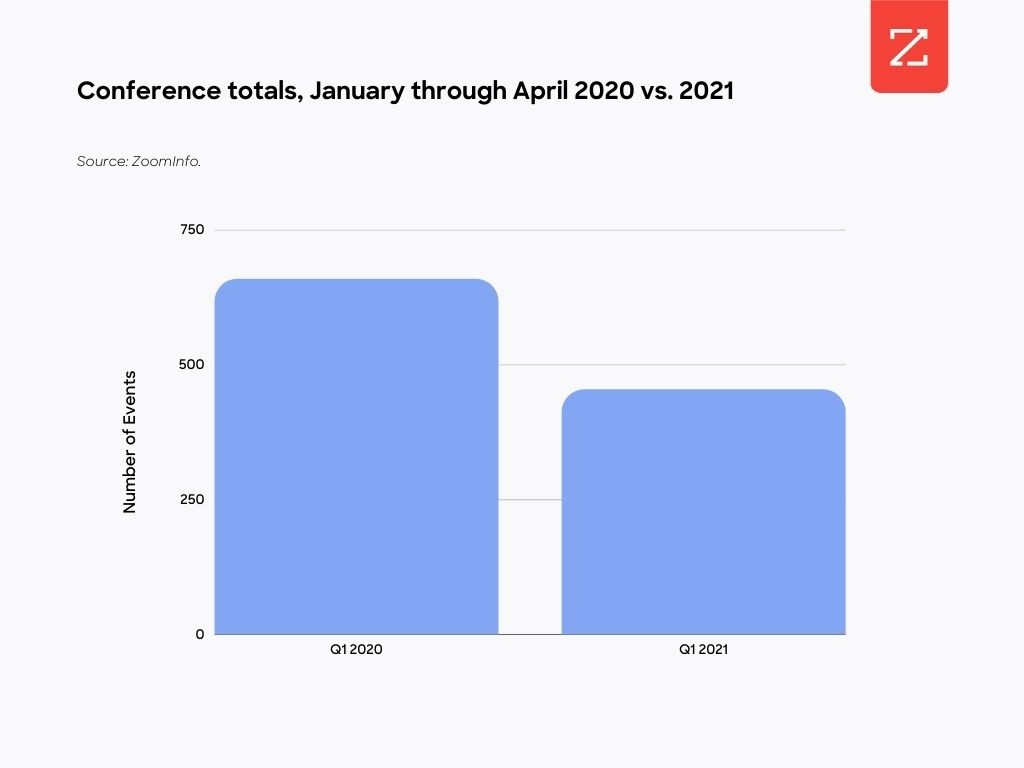“In March 2020, live events were canceled overnight. Like everyone else, we had to pivot, and fast.” — Danny Daly, manager, marketing events at ZoomInfo
Since the start of Covid-19, in-person events, conferences, and tradeshows have come to a halt. One year later, we’re virtually in the same boat, with most organizations shifting to conducting online shows to generate leads and reach prospective buyers.
Here’s what the data says:
According to a recent ZoomInfo survey of approximately 600 sales and marketing professionals, 54% of respondents said their organization hosted virtual events, while 40% stopped hosting events completely after the pandemic began in 2020.
At the same time, in-person and virtual conferences tracked in the ZoomInfo platform’s Events feature shows worldwide conference activity is down 28% in Q1 of this year compared to Q1 in 2020, while upcoming events in Q2 are down 15% this year compared to 2020. The majority of live conferences have taken place internationally, where lockdown measures have varied depending on the country.

So, what happens when the conference seat your marketing and sales team offers is your registrants’ preferred chair at home? With fewer overall events, are the number and the quality of your leads impacted?
In this quick read, we look at takeaways from the sudden switch to virtual conferences, the effect going virtual has on the customer acquisition funnel, and the implications this short-term shift can have on the long-term future of your events.
Lessons learned from virtual events
“Everyone in my world is doing virtual now — there’s little alternative,” says Shannon McCallion, director of field and channel marketing at Pcysys, a cybersecurity firm.
But are virtual events actually worthwhile? Relatively speaking, yes, with 76% of those who hosted virtual events during the pandemic reporting that they were at least somewhat effective, according to results from ZoomInfo’s survey.
But there are some caveats to consider.
1. Hot leads come from speaking sessions
With virtual conferences, prospective attendees are bombarded by sponsors. “Most third-party virtual event companies sell the full attendee list to all their sponsors, which means that aside from attendees maybe seeing your logo, you’re uploading cold leads that have had zero interaction with your brand or content,” says McCallion.
The real difference, McCallion says, is in the speaking sessions. That’s where she sees the biggest wins because those people are seeking out that content. That makes them hot leads.
Danny Daly, marketing events manager at ZoomInfo, has had the same experience. “When evaluating virtual events, we look for speaking sessions and virtual booths,” he says. “We then treat full registrants as hot leads or MQLs, and the general attendee list as cold leads, ultimately following up with everyone.”
2. Cold leads require super targeted nurturing
As a result of changes brought on by the pandemic, ZoomInfo started following up on cold leads in a more targeted way in 2020.
“Rather than splitting new business from customers, we went deeper and segmented follow-ups into buckets, like new business, existing business, enterprise, non-enterprise, and international,” Daly says.
Then those segmented leads are passed to specialized SDR teams for further follow-up, enabling personalization that was difficult to achieve from virtual events, he explains.
“Rather than splitting new business from customers, we bucketed follow-ups, and passed those leads along to specialized SDR teams for further follow-up, enabling personalization that was difficult to achieve from virtual events,” he explains.
When it comes to converting leads from a virtual event (ones made all the colder without any in-person interaction), the burden on the customer acquisition funnel is eased with enhanced segmentation.
Will virtual events stick around post-pandemic?
In 2019, virtual events were valued at close to $78 billion and are expected to grow at 23.2% annually through 2027. In 2021, 54% of respondents to ZoomInfo’s survey reported their organization definitely plans to host virtual events, and 28% say they probably will.
It’s clear that the events landscape has changed indefinitely. But is the tech landscape ready to take on the influx of virtual platforms? It appears so:
76% of app developers report that demand in the event app space was higher in 2020 than in the prior year.
One virtual events platform saw an increase of nearly 1,000% since the start of the pandemic.
B2B marketers prefer these platforms for large virtual conferences: Intrado at 31.6%, ON24 at 20.1% and Bizzabo at 14.8%.
The future of conferences is hybrid
With increased vaccine availability, the question of whether in-person gatherings recover — and to what extent — in the latter half of 2021 is playing out by the minute.
A survey conducted by Condé Nast reported that 90% of its respondents said that even once live events are back, they would still be interested in the virtual offerings.The most logical and immediate solution, it appears, is revealing itself through hybrid events that offer both in-person and remote components to appeal to a wider audience in the current climate. In fact, as of December 2020, the majority of event organizers (59.4%) reported looking for hybrid event software.
When it comes to the almighty customer acquisition funnel, organizers will need to be nimble, work smarter to drive attendance, and ensure that both their hot and cold leads are nurtured with greater attention to personalization.

